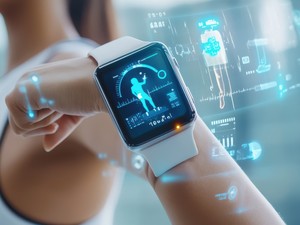Innovative biosensing technology enables next-generation wearables for individual healthcare and fitness
STMicroelectronics, a global semiconductor leader serving customers across the spectrum of electronics applications, has introduced a new bio-sensing chip for the next generations of healthcare wearables like smart watches, sports bands, connected rings, or smart glasses.
The ST1VAFE3BX chip combines a high-accuracy biopotential input with ST’s proven inertial sensing and AI core, which performs activity detection in the chip to ensure faster performance with lower power consumption.
Analysts at Yole Development see opportunities for wearable monitors transcending the general wellness market, including consumer healthcare devices that are approved by health organizations and available over the counter. By creating a complete precision sensor input in silicon, ST’s chip-design experts are facilitating innovation in all segments, with advanced capabilities such as heart-rate variability, cognitive function, and mental state.
The ST1VAFE3BX provides opportunities to extend wearable applications beyond the wrist to other locations on the body, such as intelligent patches for lifestyle or medical monitoring purposes. ST customers BM Innovations GmbH (BMI) and Pison are working at the frontiers in this sector and have quickly adopted the new sensor to drive new-product development.
BMI is an electronic design contracting company experienced in wireless sensing and with an extensive portfolio of projects including several leading-edge heart rate and performance monitoring systems. “ST’s new biosensor has enabled us to develop the next generation of precise athlete performance monitoring systems including ECG analysis in a chest band or a small patch,” said Richard Mayerhofer, Managing Director BM innovations GmbH. “Combining the analog signal from the vAFE with motion data from the acceleration sensor within a compact single package facilitates precise and context-aware data analysis. And with additional support for our AI algorithms directly on the sensor, this is exactly what we have been looking for.”
David Cipoletta, CTO of Pison, a developer focusing on advanced technologies to enhance health and human potential, added, “ST’s new biosensor stands out as a great solution for smartwatch gesture recognition, cognitive performance, and neurological health. Leveraging this advancement, we have significantly enhanced the functionality and user experience of our wearable devices.”
The ST1VAFE3BX is in production now in a 2mm x 2mm 12-lead LGA package and available from the eSTore (free samples available) and distributors from $1.50 for orders of 1000 units.
Further technical information
The analog front-end circuits for biopotential sensors are difficult to design and subject to unpredictable effects such as skin preparation and the position of electrodes attached to the body. The ST1VAFE3BX provides a complete vertical analog front end (vAFE) that simplifies the detection of different types of vital signs that can indicate physical or emotional state.
Manufacturers of wellness and healthcare devices can thus extend their product ranges to include functionality such as electrocardiography (ECG), electroencephalography (EEG), seismocardiography (SCG), and electroneurography (ENG). This can drive the emergence of new devices that are affordable, easy to use, and reliably indicate health status or physiological responses to events such as stress or excitement. The future could contain a greater diversity of wearable devices that can contribute towards enhanced healthcare, fitness, and self-awareness.
Bringing this precision front end on-chip, the ST1VAFE3BX is building on ST’s established competencies in MEMS (microelectromechanical systems) devices by integrating an accelerometer for inertial sensing. The accelerometer provides information about the wearer’s movement, which is synchronized with the biopotential sensing to help the application infer any link between measured signals and physical activity.
The ST1VAFE3BX also integrates ST’s machine-learning core (MLC) and finite state machine (FSM) that enable product designers to implement simple decision trees for neural processing on the chip. These AI skills let the sensor handle functions such as activity detection autonomously, offloading the main host CPU to accelerate system responses and minimize power consumption. In this way, ST’s sensors let smart devices provide more sophisticated functions and operate for longer between battery charging, enhancing usability. ST also provides software tools like MEMS Studio in the ST Edge AI Suite dedicated to helping designers unleash the maximum performance from the ST1VAFE3BX, including tools for configuring decision trees in the MLC.
The ST1VAFE3BX’s bio-detection signal channel comprises the vAFE with programmable gain and 12-bit ADC resolution. The maximum output data rate of 3200Hz is suitable for a wide variety of biopotential measurements to quantify heart, brain, and muscular activity.
The device is powered from a supply voltage in the range 1.62V to 3.6V and has typical operating current of just 50µA, which can be cut to just 2.2µA in power-saving mode.
The integrated low-noise accelerometer has programmable full-scale range from ±2g to ±16g.
In addition to the machine-learning core and programmable finite state machine, which can provide functionality such as activity detection, the ST1VAFE3BX implements advanced pedometer, step detector, and step counting functions.





